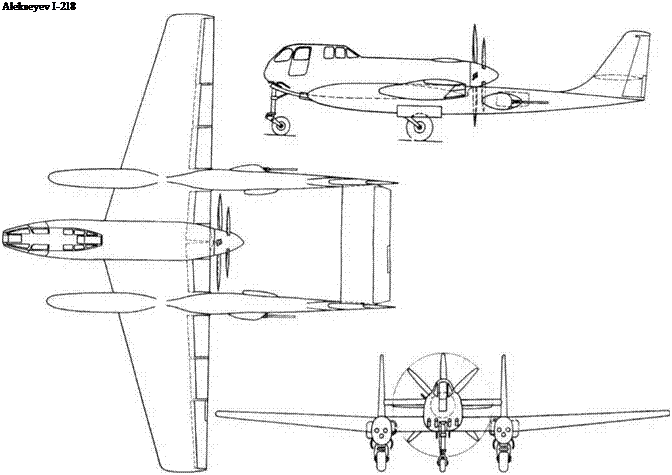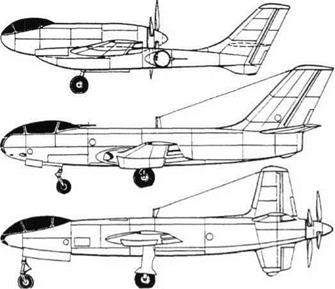SOVIET X-PLANES
Arranged principally in alphabetical order
AlekseyevI-218
 |
Purpose: To provide a high-performance Shturmovik, armoured ground-attack aircraft.
Design Bureau: Semyon Mikhailovich Alekseyev OKB-21, at Gorkii.
Born in 1909, Alekseyev graduated from MAI in 1937, and became one of the principal designers in the OKB of S A Lavochkin. Responsible for major features of the LaGG-3 and La-5 family of fighters, he was head of detail design on the derived La-7 and La-9. In 1946 he was able to open his own design bureau. He at once concentrated on twin-jet fighters with nosewheel landing gear, getting the
I-211 into flight test on 13th October 1947. Whilst working on derived aircraft with more powerful engines and swept wings, he worked in parallel on a family of multirole ground – attack aircraft.
The first of these was the I-218, or I-218-1. For various reasons, the most important being the need for long endurance at low altitude, Alekseyev adopted a powerful piston engine. He adopted a pusher layout, with the tail carried on twin booms.
A single prototype was completed in summer 1948, but in August of that year OKB-21 was closed. (A contributory factor was Yakovlev’s scathing comment that Alekseyev’s jet
fighters were copies ofthe Me 262.) At closure three derived aircraft were on the drawing board. The I-218-Ib (I-219) had a revised crew compartment, tailwheel landing gears and swept vertical tails. The I-218-11 (I-221) was an enlarged aircraft with a conventional fuselage and tail, powered by a Lyul’ka TR-3 turbojet, which was being developed to give 4,600kg (10,141 Ib) thrust. The I-218-III (I-220) was a variation on the 218-11 with a very powerful piston engine (he hoped to get a Dobrynin VD-4 of4,000hp, as used in the Tu-85 but without the turbo). Alekseyev was sent to CAHI (TsAGI) and then as Chief Constructor to the OKB-1 team of former German (mainly
 |
Junkers) engineers to produce the Type 150, described later under OKB-1.
No detailed documents have been discovered, but the I-218 was a modern all-metal stressed-skin aircraft designed to a high (fighter type) load factor. The wing comprised a centre section and outer panels joined immediately outboard of the tail booms. It was tapered on the leading edge only, and on the trailing edge were fitted outboard ailerons and six sections of area-increasing flap. The tail booms projected far in front of the wing, and carried a conventional twin-finned tail with a fixed tailplane joining the fins just above the centreline of the propeller.
The forward fuselage contained a compartment for the pilot and for the aft-facing gunner. Like some highly-stressed parts of the airframe this was made of the new 30- KhGSNA chrome-nickel steel, and it was thick enough to form a ‘bathtub’ to protect against armour-piercing shells of 20mm calibre. The windows were very thick multilayer glass/plastics slabs. The engine, mounted on
the wing, was a Dobrynin VM-251 (in effect, half a VD-4, with three banks each of four cylinders) rated at 2,000hp. It drove an AV-28 contra-rotating propeller arranged for pusher propulsion, comprising two three-blade units each of 3.6m (11ft l0in) diameter.
The I-218 was intended to have heavy forward-firing armament, such as four NR-23 guns each with 150 rounds or two N-57 (30 rounds each) and two N-37 (40 rounds each). In addition provision was to be made for up to 1,500kg (3,307 Ib) of bombs or other stores, carried mainly under the fuselage, or six 132mm (5.2in) rockets or 16 RS-82 rockets carried under the wings.
For defence, the backseater could operate a remotely-sighted system controlling an NR-23 cannon on the outer side of each tail boom. Each of these powerful guns was fed from a 120-round magazine, and was mounted in a powered barbette with angular limits of ±25° vertically and 50° outwards. Avionics included 12RSU-10 radio, RPKO-10M radiocompass, RV-2 radar altimeter and SPU-5 intercom.
Though the I-218 was built there is no positive evidence that it flew, apart from the fact that the specification does not include the word ‘estimated’ for the flight performance. The fact is, in 1948 such aircraft were regarded as obsolescent. A rival, also abandoned, was the IL-20, described later.
|
Dimensions Span Length Wing area |
16.43m 13.88m 45m2 |
53 ft M in 45 ft &A in 484.4ft2 |
|
Weights (unknown except) |
||
|
Normal loaded weight |
9,000kg |
19,840 Ib |
|
Maximum |
10,500kg |
23,148 Ib |
|
Performance |
||
|
Max speed, at sea level |
465km/h |
289 mph |
|
at 2,000m (6,562 ft) |
530km/h |
329 mph |
|
Take-off run |
520m |
1,706ft |
|
Landing run |
600m |
1,969ft |
|
Time to reach 5,000 m |
5min |
16,400ft |
|
Service ceiling |
6,000 m |
21,650ft |
|
Range |
1,200km |
746 miles |

|
|
|











